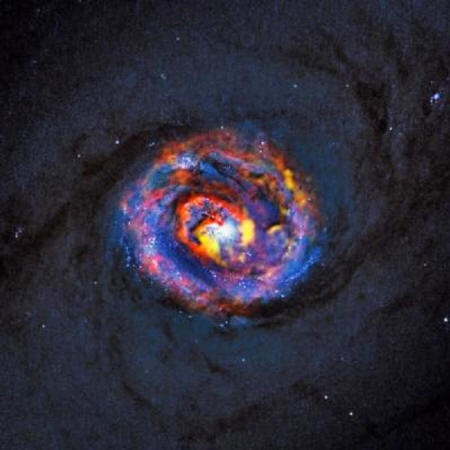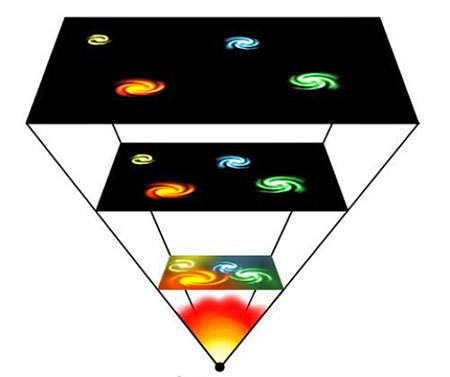|
December 12, 2013 from ScienceDaily Website
Physicists have long predicted that the universe may one day collapse and that everything within it will be compressed into a small, hard ball. Now, new calculations confirm this prediction and shows that the risk of collapse is actually greater than expected. This detailed view shows the central parts of the nearby active galaxy NGC 1433. The dim blue background image, showing the central dust lanes of this galaxy, comes from the NASA/ESA Hubble Space Telescope. The colored structures near the center are from recent ALMA observations that have revealed a spiral shape. Photo : ALMA (ESO/NAOJ/NRAO)/NASA/ESA/F. Combes)
Physicists have long predicted that the universe may one day collapse, and that everything in it will be compressed to a small hard ball. New calculations from physicists at the University of Southern Denmark now confirm this prediction - and they also conclude that
the risk of a collapse is even greater
than previously thought.
Everything - every grain of sand on Earth, every planet in the solar system and every galaxy - will become millions of billions times heavier than it is now, and this will have disastrous consequences:
This violent process is called a phase transition and is very similar to what happens when, for example water turns to steam or a magnet heats up and loses its magnetization.
The phase transition in the universe will happen if a bubble is created where the Higgs-field associated with the Higgs-particle reaches a different value than the rest of the universe.
If this new value results in lower energy and if the bubble is large enough, the bubble will expand at the speed of light in all directions.
All elementary particles inside the bubble will reach a mass, that is much heavier than if they were outside the bubble, and thus they will be pulled together and form supermassive centers.
More specifically he and his colleagues looked at three of the main equations that underlie the prediction of a phase change.
These are about the so-called beta
functions, which determine the strength of interactions between for
example light particles and electrons as well as Higgs bosons and
quarks.
After the Big Bang all material was ejected into the universe from one small area, and this expansion is still happening.
At some point, however, the expansion will stop and all the material will again begin to attract each other and eventually merge into a small area again.
This is called the Big Crunch.
Although the new calculations predict that a collapse is now more likely than ever before, it is actually also possible, that it will not happen at all. It is a prerequisite for the phase change that the universe consists of the elementary particles that we know today, including the Higgs particle.
If the universe contains undiscovered particles, the whole basis for the prediction of phase change disappears.
In these years the hunt for new particles is intense.
Only a few years ago the Higgs-particle was discovered, and a whole field of research known as high-energy physics is engaged in looking for more new particles.
Also the theory of super symmetry
predicts the existence of yet undiscovered particles, existing
somewhere in the universe as partners for all existing particles.
According to this theory there will be a selectron for the electron,
a fotino for the photon, etc.
where the Higgs particle-associated Higgs-field will reach a different value than the rest of the universe. If this new value means lower energy, and if the bubble is large enough, the bubble will expand at the speed of light in all directions. All elementary particles inside the bubble will reach a mass that is much heavier than if they were outside the bubble, and thus they will pull each other into supermassive centers. (Credit: Image courtesy of University of Southern Denmark)
If this new value means lower energy, and if the bubble is large enough, the bubble will expand at the speed of light in all directions.
All elementary particles inside the
bubble will reach a mass that is much heavier than if they were
outside the bubble, and thus they will pull each other into
supermassive centers.
In their work the researchers assumed
valid the current knowledge of the standard model interactions
augmented by the discovery of the Higgs and the latest mathematical
constraints.
|


